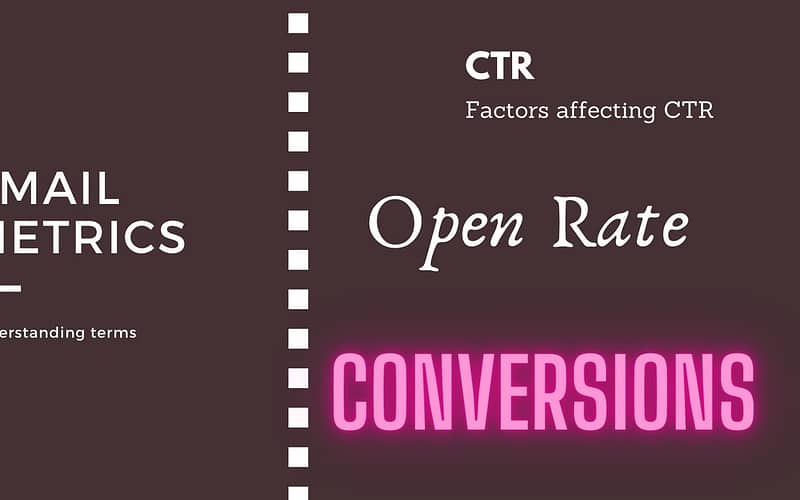Email Metrics Definitions :
Email Metrics Definitions and the 4 Factors Affecting :
Purpose of an email metrics definitions campaign is to perform the following tasks:
• To project you as an expert in your field of business.
• To create an environment of trust and confidence.
• To persuade your prospects to join your list.
• To help you to build a strong relationship with your subscribers.
• Finally, to convince your patrons to buy your products or services.
These are some email metrics definitions.

Email Metrics Definitions
- Open rates.
- Click-through rates.
- Conversions.
Each email metric definitions tells you something about your email marketing program.
- Open rates measure – things as trust, effective subject lines, timing and frequency
- click-through rates illustrate how effective things as content, layout, offers and link placement are reaching to your audience.
- Conversions– whether requesting information or purchasing a product, demonstrate the effectiveness of an email marketing program.
Open rates and click-through rates by themselves can be misleading. To get a better understanding, lets take a look at each one individually. These are some email metrics definitions.
Email Marketing Open Rate
Open rates are calculated as follows:
OR = unique opens / total number of emails delivered
The total number of emails delivered is the difference between number of emails sent and total number of bounces. So you may have sent out 10,000 emails, but 1,000 bounced so only 9,000 were actually delivered.
Lets say that there were 3,200 unique opens. Plug that into the equation and you get a 35 percent open rate.
Open rates, however, are misleading for 4 reasons:
- Preview Panes
- Blocked Images
- Delivery Issues
- Text Versions
Many email clients have a preview pane, and image blocking is a default setting. If the images remain blocked, even though a reader may be viewing the email, it will not count as an open because no image download took place to signal an open. These are something about email metrics definitions.
In terms of delivery, messages that are undeliverable, get filtered out as junk or caught in a SPAM queue do not generate a bounce message and are considered delivered. Email Metrics Definitions.
So in our example of 9,000 delivered, that number might only be 8,000. Now the open rate is 40 percent instead of 35.
Open rates may not include text versions either as there is no image associated with them. A text version is considered “open” when a link is clicked.
Though the above equation is the accepted definition of an open, not all marketers adhere to that definition. Email metrics definitions. Some measure total opens instead of unique opens, leading to inflated open rates as a reader could open the email more than once.
Others measure opens against total emails sent instead of emails delivered so bounces are counted. Email metrics definitions and something about it.
Email Marketing Click-Through Rate
The other common metric is click-through rates. A click-through is generally calculated as follows:
CTR = unique clicks / number of emails delivered
The total umber of emails delivered is the difference between number of emails sent and total number of bounces. So you may have sent out 10,000 emails, but 1,000 bounced so only 9,000 were actually delivered.
Lets say that there were 1,500 unique clicks. Plug that into the equation and you get a CTR of 16.6 percent.
Click-through rates do not take into account the number of emails opened, only the number of emails delivered. Just like with open rates, emails that do not generate a bounce are considered delivered.
Using our original example, if 8,000 emails were delivered but there were still 1,500 unique clicks, CTR is 18.75 percent instead of 16.6

To gauge the true success of you email marketing campaign, you need to look at what is called the click-to-open rate.
In Email Metrics Definitions.
Email Marketing Click-to-Open Rate
The click-to-open rate is calculated as follows:
CTOR = unique clicks / unique opens
CTOR combines the measurements of open and click-through rates that are used to determine the effectiveness of an email marketing campaign.
CTOR also provides a better perspective on the success of the parts of an email metrics definitions marketing campaign:
• Offer and content
• Design and layout
• Timeliness and frequency
• Link placement
• Level of trust
Each factor plays an important part in the success of your email marketing campaign. If the offer isn’t enticing, if the copy is poorly written and the design hinders a reader’s ability to understand the message, then your CTOR will be low and you will not be getting the full benefit of your email marketing campaign.
Another important metric to measure, especially for an eCommerce website, is click-through to conversion rates. The simplest way to do so is to integrate your email marketing campaign with your website statistics, giving you the ability to track not only click-through to conversion rates, but also where in the process people are dropping out.
From that information, you can better refine your entire email marketing campaign and better leverage the three tenants of marketing: List, Offer and Creative.
BENCHMARKS*
- Average Delivery Rate: 93.6%
- Average Open Rate: 19.8%
- Average Click-Through Rate: 5.9%
Email Response: Click-Through Rates
Once you’ve got the email delivered and opened, the next step to maximise response rates is to get the recipient to click.
The table below shows how your click-through rate affects your overall response rate and the number of leads/sales you generate:
| Emails delivered | Open rate | Opens | CTR | Unique Clicks | Response rate | Conversion rate | No. of Leads/Sales |
| 10,000 | 30% | 3,000 | 10% | 300 | 3.0% | 3% | 9 |
| 10,000 | 30% | 3,000 | 15% | 450 | 4.5% | 3% | 13.5 |
| 10,000 | 30% | 3,000 | 20% | 600 | 6.0% | 3% | 18 |
| 10,000 | 30% | 3,000 | 25% | 750 | 7.5% | 3% | 22.5 |
| 10,000 | 30% | 3,000 | 30% | 900 | 9.0% | 3% | 27 |
=> A 20% click-through rate generates 33% more leads/sales than a 15% click-through rate. For this Email Metrics Definitions.
The 4 Factors That Affect CTR:

As in telemarketing, the relative importance of target audience, offer and execution is 6:3:1 — it’s essential to know exactly who you’re talking to! In Email Metrics Definitions.
- List quality
As mentioned previously, your email marketing campaign is only as good as your list.
The more recent the data, the better the quality of the list. - Target audience (demographics)
Who is your target audience?
The best offer in the world sent to the wrong demographic audience will get a poor response. - Offer
A strong compelling offer is essential to generate high response rates. And it needs to be tailored to your target audience.
Attention spans are short – always lead with your strongest or most important information first. - Creative
Text v HTML:
Most business users use Outlook, so HTML is often the format of choice for permission-based email marketers.
B2B direct email: 87% use HTML, 9% use text, 4% use rich-media.
B2B e-newsletters: 57% HTML, 39% text, 4% rich-media
There are 3 major benefits that HTML has over text:
- links displayed can be much shorter (eg “click here”)
- HTML email often gets better response rates
- you can get additional tracking data (open rates)
And one major disadvantage:
- HTML emails are often done so poorly that the email ends up being unreadable!
- Another disadvantage of HTML is that support for HTML is dependent on the recipient’s email client.
- Email clients do NOT have the same capabilities as a full-featured web-browser. And many email broadcasting software programmes don’t send email in multi-part MIME format (where a text alternative to HTML is included in your message) which further compounds the problem.
It is also important to note that if you are mailing to a corporate network, many system administrators will strip HTML from your message (or block it completely), so it is essential that your mailing software supports multi-part MIME format.
You may want to stick with plain text in these instances.
Unlike HTML, poorly formatted plain text messages are still readable. A poorly formatted text email looks like this:
Thank you for requesting information about our services. The staff at XYZ Company would like to thank all our customers…
There are two reasons why email messages may turn out looking like the above:
- Line length
When composing email, most people just type without using a hard carriage return. If it looks fine when you’re done, your email program probably automatically wraps the words. - Proportional character fonts
There are fixed-pitch fonts (Courier) and proportional spaced fonts (Verdana). - With fixed-pitch fonts, all characters in a paragraph line up directly above each other. With proportional-spaced fonts, CAPS, space bars and other keystrokes are wider, so each line becomes a different length
- By using fixed-pitch fonts (Courier), and a hard carriage return at the end of each line at 60-65 characters, you can avoid the formatting problem shown above.
- Rich-Media:
Although most business users have broadband, it is not recommended that you send rich-media emails (emails that contain Flash, audio, etc) since rich-media is dependent on plug-ins and scripting support – there is no guarantee that they will display as intended. In fact, it’s pretty unlikely.








